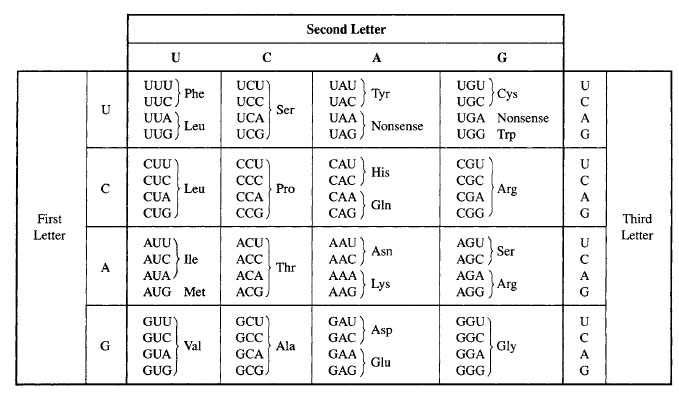The Genetic Code
A group of three adjacent nucleotides in DNA is transcribed into three complementary RNAnucleotides, which in turn are translated into a single amino acid within a polypeptide chain. Being a triplet code, 43 = 64 different combinations exist, which is many more than are necessary to encode 20 different amino acids. Each coding triplet is referred to as a codon. Each mRNAcodon in Table 5.1 is conventionally written with the 5' nucleotide at the left and the 3' nucleotide at the right, because protein synthesis begins at the 5' ends of mRNAmolecules and proceeds toward their 3' ends.The code is highly degenerate in that more than one codon can specify the same amino acid. Because of code degeneracy, many changes (mutations) can occur in a gene that will have no effect on the amino acid composition of the gene product. Such changes are referred to as silent mutations. The complementary base pairing between an mRNA codon and its anticodon in a tRNA is usually much less restrained at the third position than in the other two positions of the triplet. This phenomenon, called wobble, allows the same tRNAto recognize more than one mRNA codon in many cases.
 |
| Table 5.1 Codons (displayed as mRNA triplets) |
The codon 5'-AUG-3' near the end of an mRNAmolecule is the usual start (initiation) codon that places methionine at the beginning (amino end) of all nascent eukaryotic polypeptide chains. Sixty-one codons are sense codons that specify amino acids. There are three codons that are not recognized by any tRNA: UAA, UAG, and UGA. These are termed nonsense codons or stop codons, because they provide part of the signal that protein synthesis should stop at that point. The completed polypeptide can be released from its cognate tRNA and from the ribosome.
Notes
The genetic code is universal! Essentially, the same codons encode the same amino acids in all organisms!




